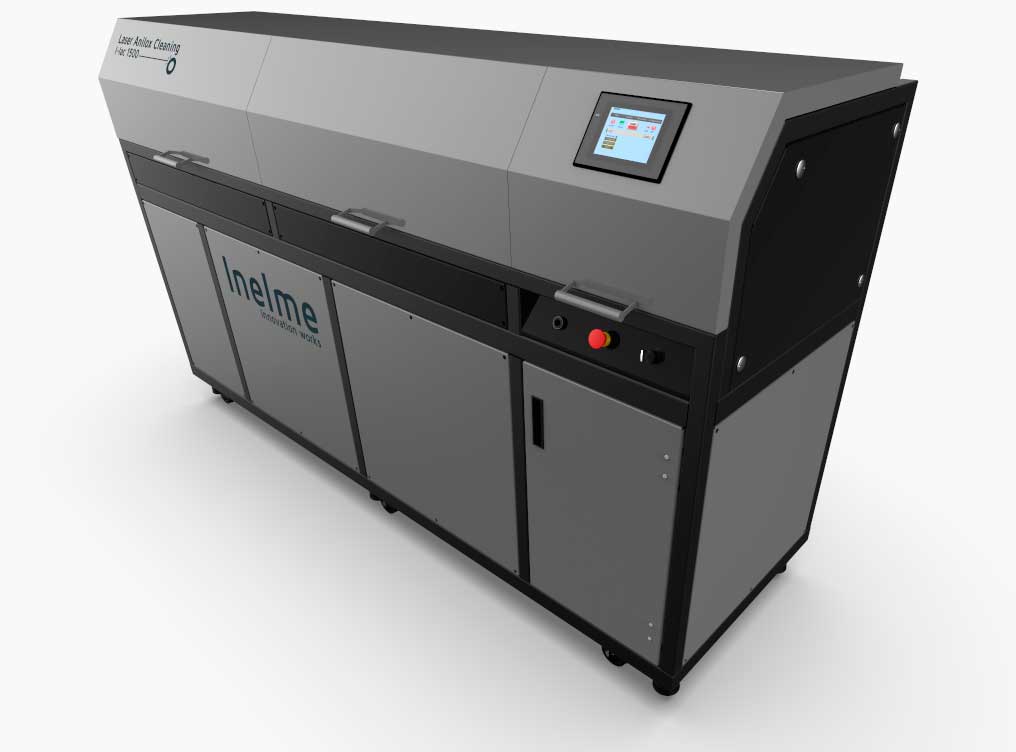The necessity for a laser cleaning ceramic anilox used in the flexographic printing process occurs after the implementation of the doctor blade and the change of the material on which the surface of these anilox instruments are manufactured.
Why is laser cleaning ceramic anilox important?
Thanks to the fact that the wear caused by the friction of the rubber rollers now replaced by the doctor blade was very low, the anilox were initially made of chromed steel strong enough for this anilox rubber configuration.
With the arrival of the doctor blade, the anilox now suffers wear caused by two steel blades, so it is necessary to manufacture them in a much more resistant material: ceramics.
The new material, unlike chrome, is very porous, which makes cleaning difficult. In addition, the cylinders can now have literature of hundreds of lines per centimeters with very small sockets that get dirty soon and are much harder to clean.
While these high standards have led to flexography at very high levels of print quality, comparable to other printing systems, several problems related to maintaining anilox have also been added.
The main problem, apart from the fragility of the cells that scratch more easily, is the difficulty of cleaning them and how quickly the cells get filled with dry ink that reduces the volume of roller input very quickly.
This problem of dullness of the cells produces adverse effects, such as less intense impressions, difficulty in reaching the desired color, and most importantly: a substantial increase in intonation time when starting a new print job even if it was a repetition of a job already done. Long periods of the printer being stopped results in production losses.
The most obvious solution is to keep the cylinders clean every time a new job is started.
Maintenance and laser cleaning ceramic anilox
To maintain the cylinders with 100% of their available volume, several cleaning techniques can be used, from chemicals to bicarbonate projection, ultrasound, etc.
The most effective and least damaging system for an anilox cylinder is the cleaning with a laser beam that eliminates the remains of ink inside the socket by 100%. Effectiveness that is far greater than that achieved by other cleaning systems. and since it is a treatment without chemical or mechanical agents—it does not deteriorate the cells of the cylinder. In this way the cylinder can undergo a daily cleaning process without affecting its characteristics.
The cost of cleaning with this system is also the most economical since it does not require products and does not generate any waste that has to be disposed of.
Finally, the laser helps us to eliminate the ink that is deposited inside the sockets by heating the resin of the ink until it becomes gas. The pigment is suspended in the air that is evacuated from the inside of the machine by an extraction system.
How often should the anilox cylinder be cleaned?
The recommended cleaning frequency of an anilox cylinder is every time it leaves the machine to be replaced or at the latest once a week. It is important to keep in mind that the cylinders get dirty every time a job is finished in the cleaning and drying process. It does not get dirty in the printing process, but every time it is cleaned and is stopped to wait for the next job. The more changes are made, the more layers are deposited inside the socket.
Is laser cleaning safe?
Things to keep in mind when choosing a laser cleaning ceramic anilox
• It should not degrade the pottery. Chemicals and the action of ultrasound systems can deteriorate them, the mechanical action of particle projection is undoubtedly the least recommended for its abrasive action and the impossibility of cleaning high-line anilox, with very small sockets, in which solid particles used in this type of cleaning cannot enter.
• It should be effective. It is the best option to use cleaning systems that achieve an efficiency of less than 90% and that also will not be uniform, sometimes 80% is achieved, in others 90%. Therefore, a uniform volume is not achieved and, consequently, there is a reduction of the color intonation time as the volume of ink contributed by the anilox becomes a variable and not a counter as would be desirable.
• The last aspect to consider is the cleaning speed. The more speed, the more cylinders can be cleaned, so the cleaning cycles of the cylinders can be reduced to be less than once a week.
